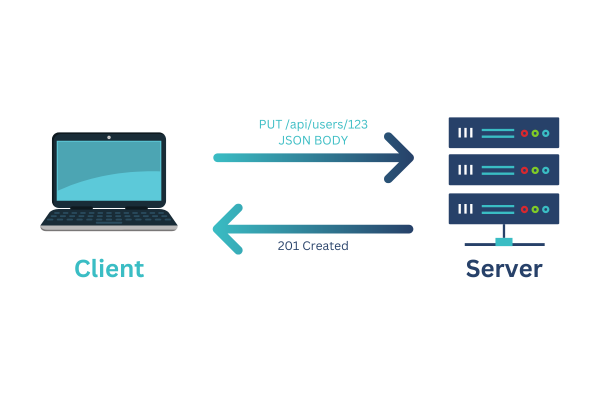The PUT method in REST APIs (Representational State Transfer Application Programming Interfaces) is your go-to tool for updating existing resources or creating new ones when the client fully defines the resource. Unlike the non-idempotent POST method, PUT ensures that multiple identical requests have the same effect, making it a reliable way to manage resource states.
In this comprehensive guide, we’ll dive deep into the PUT method, exploring its syntax, usage, best practices, and common pitfalls to avoid.
What is the PUT Method in REST APIs?
The PUT method is an HTTP verb that instructs the server to replace the entire state of a resource with the representation provided in the request body. Think of it as a complete overwrite, replacing the old version of the resource with the new one you provide.

Anatomy of a PUT Request
A typical PUT request includes the following components:
- HTTP Verb: PUT
- Endpoint (URI): The specific resource location you want to update (e.g.,
/api/users/123). This URI should include a unique identifier to target a particular resource. - Headers: Contain metadata like authentication tokens and content type (usually
application/jsonorapplication/xml). - Request Body: The full representation of the resource in the desired format (JSON, XML, etc.). This includes all fields, even those that remain unchanged.
Example: Updating a User Profile
PUT /api/users/123 HTTP/1.1
Content-Type: application/json
{
"name": "Alice Johnson",
"email": "alice.johnson@example.com",
"age": 31
}
PUT Method Responses
The server’s response to a PUT request can vary depending on the outcome:
- 200 OK: If the resource was successfully updated, the server may return a representation of the updated resource in the response body.
- 201 Created: If the resource did not previously exist and was created, this status code indicates success, and the response often includes the URI of the newly created resource in the
Locationheader. - 400 Bad Request: The request was invalid (e.g., malformed data).
- 404 Not Found: The specified resource was not found.
Best Practices for PUT Requests
- Idempotence: Ensure that multiple identical PUT requests have the same effect as a single request, preserving data integrity.
- Complete Representation: Send the entire resource representation in the request body, even if only a few fields are being updated.
- Partial Updates: Use the PATCH method for partial updates where only specific fields need to be modified.
- Validation: Thoroughly validate the data in the request body to prevent errors and potential security vulnerabilities.
FAQs: PUT Method in REST API
Q: What’s the difference between PUT and POST?
A: PUT is for updating existing resources (or creating them if they don’t exist at a specific URI), while POST is used for creating new resources with the server determining the URI. PUT is idempotent, while POST is not.
Q: Can I use PUT for partial updates?
A: It’s not recommended. Use the PATCH method for partial updates to avoid unintended data overwrites.
Q: How does PUT handle conflicts when multiple clients update the same resource simultaneously?
A: You can use optimistic locking (using an ETag or Last-Modified header) or implement conflict resolution strategies on the server-side.